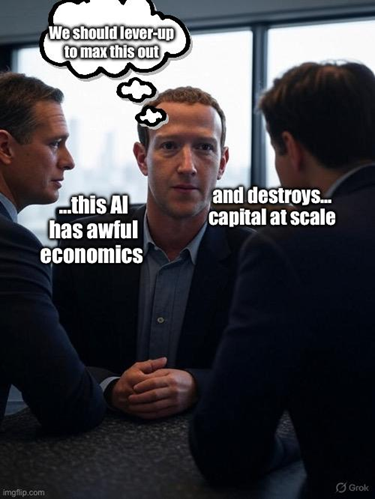The $1 Trillion Question
Without The AI Buildout, The U.S. Economy Might Already Be In Recession
Every few years, a piece of writing cuts through the noise of hype and forces you to confront the numbers. Harris Kupperman’s latest essay, “An AI Addendum,” is one of those.
Kupperman, a hedge fund manager known for spotting cyclical extremes, revisits the AI boom not through the lens of innovation, but through the cold logic of capital allocation. His conclusion is unnerving: the math behind the AI infrastructure build-out doesn’t make sense.
And yet, everyone keeps building.
The $400 Billion Illusion
The world’s hyperscalers are spending roughly $30 billion a month, or $400 billion this year, on AI data centres; buildings stuffed with GPUs, cooling systems, and servers that train large language models. On paper, this looks like the most ambitious corporate investment programme in history. In practice, it might be the most unprofitable.
The original analysis assumed the data centres would depreciate over ten years. Using that timeline, the industry would need about $160 billion in annual revenue just to break even on 2025’s spending.
But after speaking with dozens of insiders, from engineers to lenders, Kupperman realised the reality is far worse. Hardware lifecycles are collapsing. Data centres now become obsolete in as little as three–five years, not ten.
Update that assumption, and the breakeven revenue target doubles or triples, to somewhere between $320 billion and $480 billion. Today, AI-related revenues sit around $15–20 billion a year. An abyss of a gap.
When the Inputs Outrun the Outputs
If the industry spends $400 billion this year and another $400 billion next year, it would take roughly $1 trillion in annual revenue to simply cover costs, not to earn a profit, but to break even on the combined Capex.
Every new data centre must generate returns fast enough to offset its rapid obsolescence. But every new GPU generation shortens that window even further. The treadmill is accelerating, and no one can afford to step off.
The Bubble Beneath the Boom
Kupperman’s sharpest insight is historical: AI is following the script of every capital-intensive revolution before it. The railroads of the 19th century connected a continent but bankrupted their builders. The fibre-optic networks of the 1990s carried the internet to billions, after destroying trillions in market value.
The pattern rhymes. Each time, overbuilt infrastructure created the future, but only after vaporising investor capital. If AI follows the same path, the technology may endure long after the current economic logic collapses.
The GDP Mirage
It’s estimated that AI Capex now represents about 1.5% of U.S. GDP, and closer to 2% once upstream industries (power generation, steel, real estate) are included. Add in the wealth effect from surging AI stock prices, and the sector could be responsible for the entirety of U.S. GDP growth in 2025. That’s a staggering implication: without the AI buildout, the U.S. economy might already be in recession.
Every bubble has a reflexive loop. AI Capex props up GDP → GDP props up asset prices → asset prices justify more Capex.
But when investors get tired of funding this loop, it unwinds violently. Spending halts, valuations fall, the wealth effect reverses, and because AI infrastructure depreciates so quickly, there’s almost no salvage value left.
Unlike railroads, you can’t reuse an obsolete GPU farm. It’s just a warehouse full of expensive s(crap).
The Historical Echo
At the height of the dot-com boom, companies juiced growth by selling hardware to customers they also financed, then booking those sales as revenue, a circular flow that masked fragility.
This feels eerily relevant as similar patterns emerge around Nvidia. In its latest quarter, inventory rose from $11 billion to $15 billion, days on hand jumped past 100, and accounts receivable climbed $5 billion, suggesting a buildup of GPUs and downstream bottlenecks.
More concerning are Nvidia’s circular arrangements: a $6.3 billion deal with CoreWeave, in which it sells GPUs and commits to buy back residual compute through 2032; a $1.5 billion leaseback with Lambda that makes Nvidia its largest customer ahead of an IPO; and an “up to $100 billion” OpenAI partnership that intertwines supplier, investor, and client roles.
None of this is fraudulent, it may even be strategic, but when vendor, buyer, and financier become the same entity, reported demand can inflate reality, and what once looked like exponential growth can, in hindsight, resemble 2000-era reflexivity with better branding.
The $1 Trillion Question
When the inevitable slowdown arrives, the fallout could reverberate through GDP, consumption, and employment, because we’ve built an entire economy atop a narrative that doesn’t add up.
The economics of the current AI buildout don’t work. But the system can keep funding it for years because (1) sunk costs are enormous, (2) power contracts are locked in, and (3) the illusion of growth supports asset prices that fund the next round of spending.
AI may yet change the world. But the first revolution, as always, will be financial.
Read the essay: “An AI Addendum” by Praetorian Capital





Extraordinary resources requires extraordinary returns. If we are going to put in the energy of India then we have to cure cancer. Full stop.
https://open.substack.com/pub/pramodhmallipatna/p/ais-grand-entanglement-the-subprime